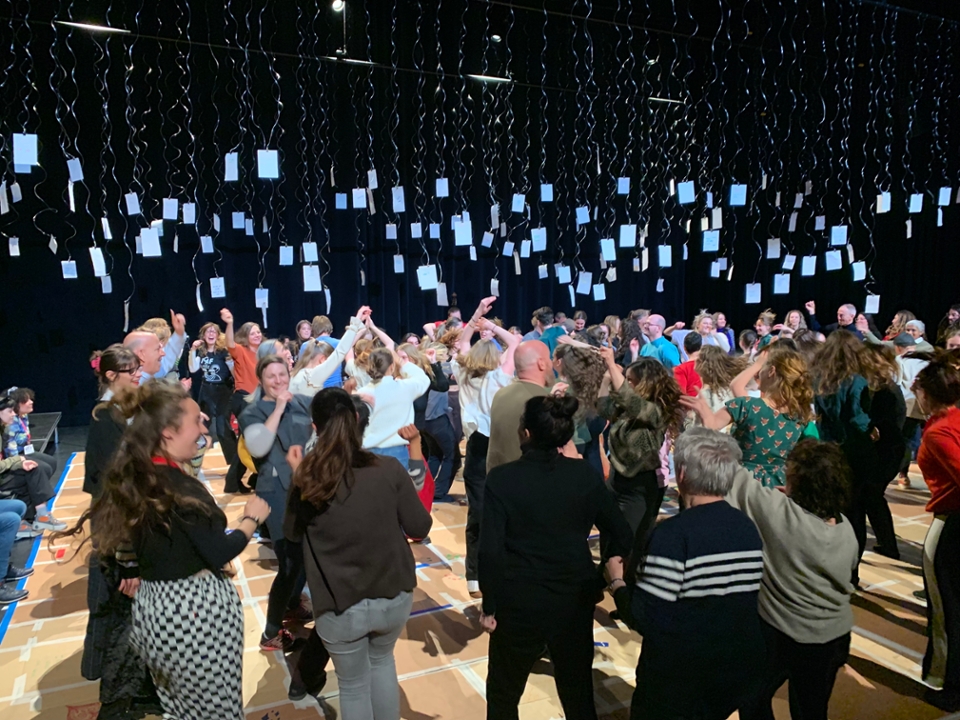A Village Dances

Photo Credit: Armine Avetisyan
By Dessa Quesada Palm, Artistic Director of the Youth Advocates Through Theater Arts, Dumaguete City in the Philippines, IMPACT board member
We came into the blackbox theater and were immediately welcomed by young smiling ushers who handed us an index card and a marker. On the paper, an instruction to write something that you love had been scribbled. As more people entered, paper and pen were collected, and the sheets found their way to clips attached to twirling wires (lots of them) hanging on the center stage’s ceiling, akin to hanging vines, audiences spread out in a U shape. A live band had already played music.
The invitation to engage is immediately set up. And soon everyone in the mood to move congregated in the middle for an animated warm up accompanied by musicians playing a pulsating 4/4 rhythm. There was a blurring of the lines between audience and the team of performers, because as soon as the warm-up was over, the group’s choreographer-facilitator Jordy Dik went into a well-designed process of simultaneous dramaturgy. One group worked on creating movement duets, another in solos, yet another in ensemble, and there was us, in Augusto Boal’s nomenclature, the “spect-actors” who were co-creating with everyone else, ably threaded by Jordy’s team. Motifs were gathered from people’s responses to the question of what they loved, gestures inspired by people’s ideas, and connected.
The collective performance begins to emerge as pockets of creative movement pieces developed in various parts of the theater were incrementally strung together, and then other elements added like poetry, and more nuanced music. At all times, the community was involved, volunteers were drawn in, until this beautiful poetry in motion began to take shape. It was awe-inspiring.
In the program notes, the process is described as:
Relations (live) is a performative gathering of all those present. All bodies, in one shared space. From the moment you enter, we will begin to create something completely new together with people you don’t know, and might otherwise never meet; a so-called Relational Choreography.
In preparation for this instant choreography, the group, consisting of performers of Tiuri and Codarts, have worked intensely together for three days as part of a learning exchange. Tiuri is a place where people with disabilities are trained to become performers, and where their hidden talent comes to the surface. Jordy Dik is a community artist and the resident choreographer of Compagnie 21, Tiuri’s professional dance and theatre company. Four years ago, Jordy co-created a choreographic method called Relational Choreography. The goal was to be able to quickly and collectively make dance art with ‘anyone’ and ‘everyone’ present. In the now-moment, impulse-following movements emerge, which soon fills the performative space with meaningful relationships and stories. This method continued to build on the legacy of inclusive dance landscapes, helping to open space for autonomy, creativity and playfulness within its poetic structures. Theaterwerkplaats Tiuri believes that everyone has talent, and that those talents must be made visible, in particular for people with disabilities. The Tiuri performers, Codarts students, live musicians and, soon, you, can experience this relational process.
The piece reminded me of something about village dances that is perhaps shared by many of our ancestral heritage across the world. Not too long ago, dances were created in our villages to instruct, to celebrate, to mimic elements of nature, to connect to the spirit world and to inspire the community. All were often welcomed to these village dances: people of various ages, social strata, gender identities, and abilities. These gatherings were key to a people’s survival.
This notion of relational choreography is certainly a step towards reclaiming not what has been lost, but perhaps what is inherent in our communities but not often recognized sufficiently and intentionally in our contemporary lives. There was something fundamentally sacred about breath, body, and spirit shared in a creative experience. At the end, the village danced, invigorated by an embodied sense of shared energy and celebration of our hearts beating in collective resonance.
Dessa Quesada Palm facilitated the interactive closing program at ICAF.